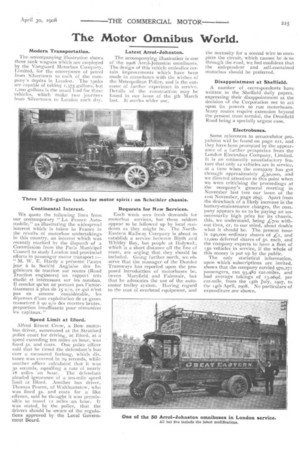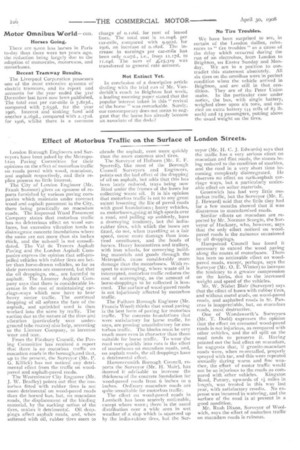The Motor Omnibus World.
Page 5

Page 6

If you've noticed an error in this article please click here to report it so we can fix it.
Modern Transportation.
The accompanying illustration shows three tank wagons which are employed by the Vanguard Motorbus Company, Limited, for the conveyance of petrol from Silvertown to each of the company's dep6ts in London. The 1..inks are capable of taking 1,375 gallons, but 1,200 gallons is the usual ILutd for thes/2 vehicles, which make two journeys from Silvertown to London each dav.
Continental Interest.
We quote the following lines from our contemporary " La France Automobile," as illustrating the widespread interest which is taken in France in the results of motorbus undertakings in this country, an interest which was recently marked by the dispatch of a Commission from the Paris Municipal Council to study London and provincial efforts in passenger motor transport :— " M. W. E. Hardy a pr6sente l'autre jour a la Soci6te Anglaise des Ing-enieurs de traction sur routes (Road Traction engineers) un rapport tres etudie et interessant sur les autobus. II conclut qu'en ne portant pas l'amortissement a plus de /5 c/o, cc qui n'est pas en somme considerable, les depenses d'une exploitation de ce genre ressortent é go o/o des recettes brutes, proportion insuffisante pour rfmunerer Les capitaux."
Speed Limit at Ilford.
Alfred Ernest Crow, a Bow motorbus driver, summoned at the Stratford police court for driving, at Ilford, at a speed exceeding ten miles an hour, was fined 5s. and costs. One police officer said that he timed the defendant's bus over a measured furlong, which dis_ twice was covered in 29 seconds, while another officer calculated that it was 30 seconds, equalling a rate of nearly 18 miles an hour. The defendant pleaded ignorance of a ten-mile speed limit at Ilford. Another bus driver, Thomas Pearce, of Walthamstow, who was fined 5s. and costs for a like offence, said he thought it was permissible to travel T 2 miles an hour. It was stated, by the police, that the drivers should be aware of the regulations approved by the Local Govern runt Beard. Latest Arrol-Johnston.
The accompanying illustration is one of the 1908 Arrol-johnston omnibuses. The design of this vehicle embodies certain improvements which have been made in accordance with the wishes of the Metropolitan Police, and is the outcome of further experience in service. Details of the construction may he found in our issue of the 5th March last. It merits wider use.
Requests for IsLaw Services.
Each week sees fresh demands for motorbus services, but these seldom appear to be followed up by local residents as they might be. The NorthEastern Railway Company is about to establish a service between Bly-th and Whitley Bay, but people at llolywell, which is a short distance off the line of route, are urging that they should be included. Going further north, we observe that the manager of the Dundee Tramways has reported upon the proposed introduction of motorbuses be tween Maryfield and Fairmuir, but that he advocates the use of the auto. motor trolley system. Having regard to the cost of overhead equipment, and the necessity for a second wire to complete the circuit, which cannot be dune through the road, we feel confident that the independent and self-contained motorbus should be preferred.
Disappointment at Sheffield.
A number of correspondents have written to the Sheffield daily papers, expressing their disappointment at the decision of the Corporation not to act upon its powers to run motorbuses. Many routes require extension beyond the present tram termini, the Dronfield Road being a specially urgent case.
EIectrobuses.
Some references to accumulator propulsion will be found on page 221, and they have been prompted by the appearance of a further prospectus from the Loodon Electrobus Company, Limited. It is an eminently unsatisfactory feature that only 12 vehicles are in service, at a time when the company has got through approximately L5o,000, and we directed attention to this point when we were criticising the proceedings at the company's general meeting in November last (see our issue of the 21st November, page 269). Apart from the drawback of a likely increase in the battery-maintenance charges, the company appears to us to be paying an unnecessarily high price for its chassis, this, we understand, being £700 without tires, or, to our mind, about double what it should be. The present issue is 240,000 ordinary shares of Li, and 12,000 deferred shares of 5s. each, and the company expects to have a fleet of iso vehicles in service, if the whole of this money is put up by the public.
The only statistical information, upon which subscriptions are invited, shows that the company carried 97o,271 passengers, ran 93,482 car-miles, and had average takings of 13.069d. per car-mile, from the i5th July, 1907, to the 14th April, 1908. No particulars of expenditure are shown. Horses Going.
There are 9,000 less horses in Paris to-day than there were ten years ago, the reduction being largely due to the adoption of motorcabs, motorvans, and motorbuses.
Recent Tramway Results.
The Liverpool Corporation possesses one of the most extensive systems of electric tramcars, and its report and accounts for the year ended the 31st December last have now been published. The total cost per car-mile is 7.823d., compared with 7.635d. for the year 1906. interest and sinking fund add another 2.165d., compared with 2.171d. for 1906, whilst there is a common
charge of o.iibd. for rent of leased lines. The total cost is 1ti.To4d. per car-mile, compared with 9.922d. for 1906, an increase of o. 182d. The increase in earnings per car-mile has been only o.o7d., i.e., from it. 7d. to I 1.24d . The sum of -.,..C25,319 was transferred to general rate account.
Not Extinct Yet.
In conclusion of a descriptive article dealing with the trial run of Mr. Vanderbilt's coach to Brighton last week, a leading morning paper stated that the popular interest taken in this " revival of the horse " was remarkable. Surely, our contemporary does not mean to suggest that the horse has already become an associate of the dodo? No Tire Troubles.
We have been surprised to see, in certain of the London dailies, references to" tire troubles " as a cause of the delay which occurred during the run of an electrobus, from London to Brighton, on Easter Sunday and Monday. We are in a position to contradict this statement absolutely. All six tires on the omnibus were in perfect condition when the vehicle arrived in Brighton, and are still in that condition. They are of the Peter Union make. In the particular case under notice, the bus, with single battery, weighed close upon six tons, and carried an extra battery (44 cells of 83 lb. each) and 15 passengers, putting above the usual weight on the tires.


































